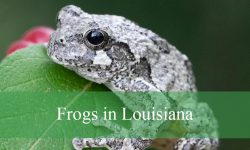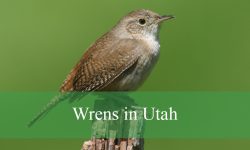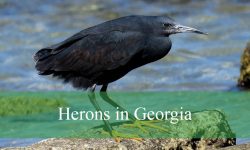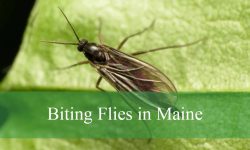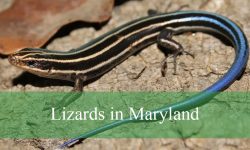Orioles are some of the most stunning and musical birds in North America, and North Carolina provides a fascinating habitat for several species. Their striking colors, sweet songs, and lively behavior make them favorite sightings for birdwatchers across the state. While some orioles are regular breeders, others are occasional visitors that appear during migration. Understanding their characteristics, habits, and seasonal presence can help enthusiasts identify them more easily.
North Carolina’s mix of woodlands, meadows, and suburban gardens offers ideal conditions for orioles. These birds thrive in areas with tall trees, open fields, and plentiful food sources such as insects, fruits, and nectar. With some knowledge, patience, and the right habitat setup, anyone can enjoy observing these elegant songbirds in their natural surroundings.
This guide covers the three types of orioles that can be seen in North Carolina: the Baltimore Oriole, the Orchard Oriole, and the rare Bullock’s Oriole. Each species has unique traits, from their plumage and song to their preferred environment. By the end, you will know how to identify them, where to look for them, and the best times of year to catch a glimpse of these vibrant birds.
Baltimore Oriole (Icterus galbula)
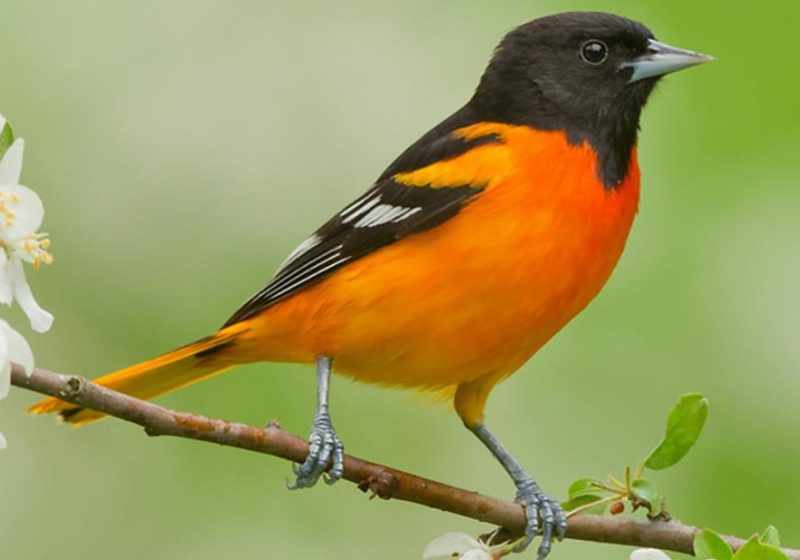
Characteristics and Identification
The Baltimore Oriole is the most recognizable oriole in North Carolina, celebrated for its brilliant orange and black plumage. Males have fiery orange underparts contrasted with a jet-black head, back, and wings, accented by white wing bars. Females and juveniles are more subdued, showing yellowish-orange tones with grayish wings. This sexual dimorphism makes it easier to distinguish males from females during the breeding season.
In addition to their color, their song is a clear whistled melody, often described as flute-like. These vocalizations are a great way to locate them among tall trees. Their woven, hanging nests are another distinctive feature, suspended like little pouches at the end of branches.
Behavior and Diet
Baltimore Orioles feed on insects, fruit, and nectar. During spring and summer, they actively hunt caterpillars, beetles, and spiders to provide protein for their young. They also seek out ripe fruits such as cherries, mulberries, and oranges. In backyards, they readily visit feeders stocked with orange halves, grape jelly, or sugar water, making them a delight for bird enthusiasts.
Their migratory behavior is another fascinating trait. These orioles arrive in North Carolina during spring, usually around late April or early May, and remain until late summer. By early fall, they migrate to Central and South America for the winter.
Habitat in North Carolina
In the state, Baltimore Orioles are commonly found in deciduous woodlands, along forest edges, and near rivers. They also adapt well to suburban neighborhoods with mature trees and fruit-bearing plants. Birders can often spot them flitting among treetops or perching in open areas to sing.
Orchard Oriole (Icterus spurius)
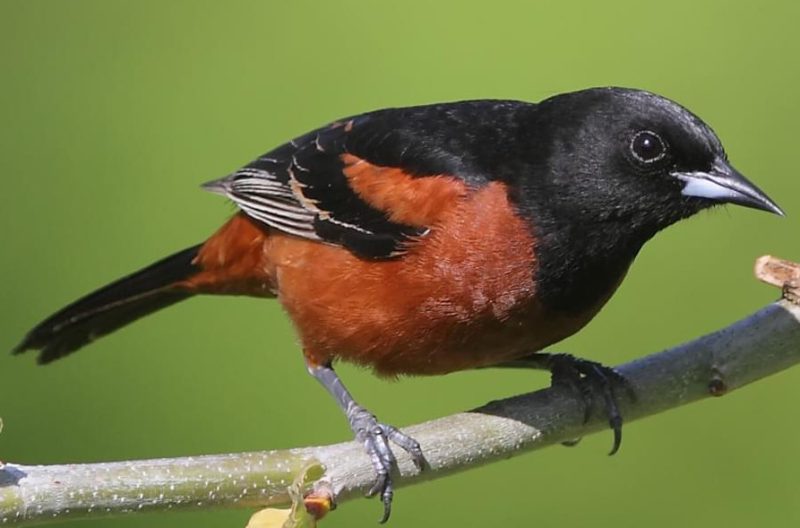
Characteristics and Identification
The Orchard Oriole is smaller and less brightly colored than the Baltimore Oriole, but equally captivating. Adult males have a rich chestnut-red belly with black head, throat, wings, and back. Females and immature birds appear olive-yellow with two white wing bars, sometimes mistaken for other songbirds until observed closely.
Their songs are fast, irregular, and less melodic than the Baltimore Oriole’s, yet still distinctive once recognized. Like their relatives, they build hanging, pouch-like nests woven from grass and plant fibers.
Behavior and Diet
Orchard Orioles feed heavily on insects, especially during the breeding season. They consume caterpillars, grasshoppers, beetles, and wasps, playing an important role in natural pest control. Later in summer, their diet shifts toward fruits such as blackberries, mulberries, and cherries. They are also known to sip nectar from flowers or feeders designed for orioles.
Unlike Baltimore Orioles, Orchard Orioles have a shorter breeding window. They often arrive in North Carolina in late April and depart as early as July or August, making their stay relatively brief. This condensed schedule means birders need to watch closely during early summer to catch sight of them.
Habitat in North Carolina
As their name suggests, Orchard Orioles prefer open woodlands, orchards, farmland, and suburban areas with scattered trees. They thrive in places where tall trees and open grassy areas are combined, making rural landscapes ideal. In North Carolina, they are especially common in agricultural regions and along river valleys.
Bullock’s Oriole (Icterus bullockii)
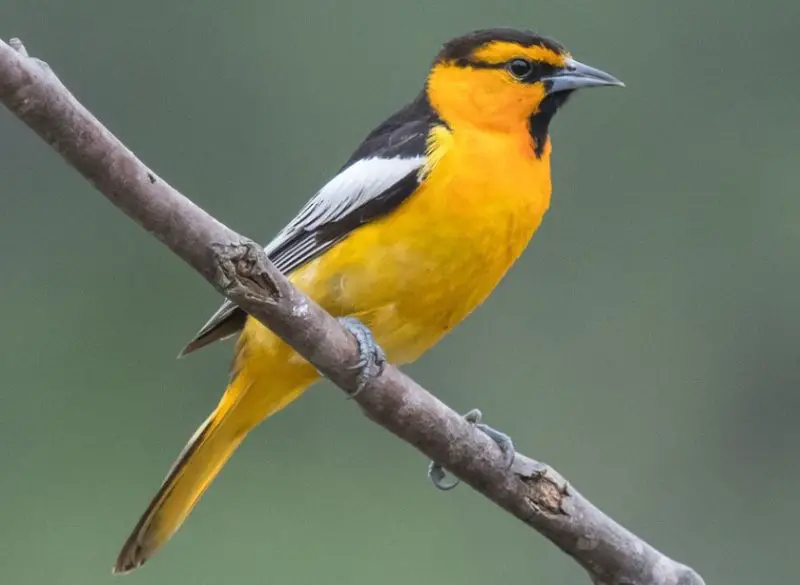
Characteristics and Identification
Bullock’s Oriole is not a common sight in North Carolina but is recorded as a rare vagrant. Typically found in the western United States, occasional individuals appear in the East, particularly during migration. When spotted, they stand out due to their striking plumage. Males have bright orange underparts, black back, throat, and crown, with a white wing patch and bold black eye line. Females are duller, showing a yellowish-orange wash with grayish upperparts.
Their song is somewhat similar to that of the Baltimore Oriole, but often more varied and less clear. Observing a Bullock’s Oriole in North Carolina is considered a special event for birders, making it a sought-after rarity.
Behavior and Diet
Bullock’s Orioles share many behaviors with other orioles, including feeding on insects, fruit, and nectar. They often forage in trees and shrubs, probing flowers for nectar or plucking insects from foliage. If they appear in residential areas, they may visit feeders offering oranges or jelly, although such sightings are sporadic.
Since this species is not a regular resident of North Carolina, there is no predictable breeding presence. Most observations occur in fall or winter, when stray individuals wander eastward outside their normal range.
Habitat in North Carolina
In their usual western habitats, Bullock’s Orioles prefer riparian woodlands, cottonwood groves, and open forests. In North Carolina, their rare appearances are typically in open fields, woodlands, or even suburban yards where food is abundant. These sightings generate excitement among local birding communities.
Comparison of Orioles in North Carolina
To better understand their differences, here is a comparison of the three oriole species that can be seen in North Carolina:
Species |
Size & Coloration |
Song & Calls |
Seasonal Presence |
Habitat Preference |
|---|---|---|---|---|
Baltimore Oriole |
Bright orange & black males; yellowish females |
Clear, flute-like whistles |
Spring to late summer (April–Sept) |
Deciduous forests, edges, suburban trees |
Orchard Oriole |
Smaller; chestnut-red males, olive-yellow females |
Fast, irregular songs |
Late April–July/August |
Orchards, farmland, open woods |
Bullock’s Oriole |
Orange with black and white; bold eye line |
Varied, less clear than Baltimore |
Rare vagrant, unpredictable |
Open woodlands, fields, suburban areas |
Best Time and Places to Observe Orioles in North Carolina
The best time to observe orioles in North Carolina is during spring and summer, when they migrate north to breed. Baltimore Orioles arrive in late April and are visible through September, while Orchard Orioles have a shorter window, usually from late April until August. Bullock’s Orioles are unpredictable and may appear in rare instances during fall or winter.
For locations, riparian woodlands, state parks, orchards, and suburban gardens with tall trees are prime spots. In the Piedmont and coastal plain, orchards and rural landscapes provide excellent viewing opportunities for Orchard Orioles. Baltimore Orioles are often found across the state, particularly in forest edges and urban areas with mature shade trees. Birders near rivers, lakes, and agricultural regions have the best chances of spotting them.
Providing feeders stocked with oranges, grape jelly, and sugar water can also attract orioles to backyards. Ensuring nearby trees for nesting and shrubs for cover increases the likelihood of consistent visits.
FAQs about Orioles in North Carolina
Are orioles common in North Carolina?
Yes, Baltimore Orioles and Orchard Orioles are relatively common in North Carolina during the breeding season. Bullock’s Orioles are rare vagrants.
How can I attract orioles to my backyard?
You can attract orioles by offering fresh orange halves, grape jelly, and nectar feeders. Planting fruiting trees and maintaining a pesticide-free yard also encourages them.
Do orioles stay in North Carolina year-round?
No, orioles are migratory birds. They arrive in spring, breed through summer, and migrate south in fall. Only rare individuals, such as stray Bullock’s Orioles, may appear outside the regular season.
Where is the best place in North Carolina to see orioles?
Deciduous woodlands, orchards, river valleys, and suburban neighborhoods with mature trees are excellent locations. Baltimore Orioles are widespread, while Orchard Orioles prefer more open rural areas.
What do orioles eat in the wild?
Orioles eat insects, fruit, and nectar. They consume caterpillars, beetles, spiders, cherries, mulberries, and flower nectar depending on the season.
Final Thoughts
Orioles bring a splash of vibrant color and cheerful song to North Carolina each year. While Baltimore Orioles and Orchard Orioles are the most reliable visitors, the rare Bullock’s Oriole adds an exciting twist for birdwatchers. By knowing their identifying traits, habitats, and migration patterns, enthusiasts can maximize their chances of spotting these striking songbirds.
Creating a bird-friendly environment with fruit, nectar, and safe nesting areas makes it possible to enjoy orioles up close, even in backyards. Whether in forests, orchards, or suburban neighborhoods, these birds enrich the natural beauty of North Carolina.

